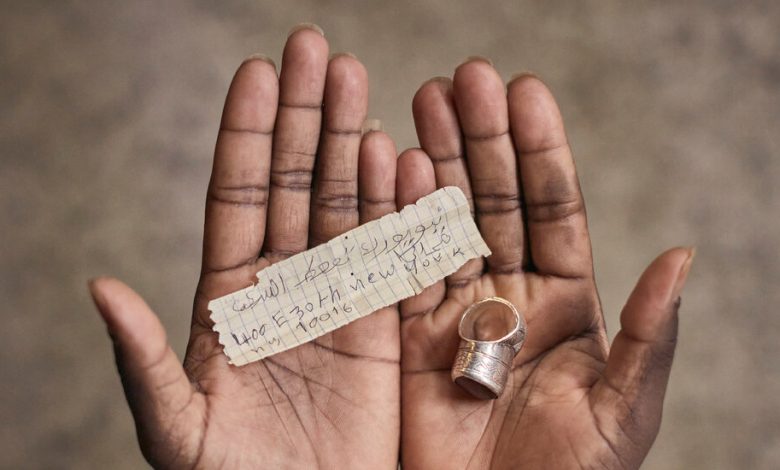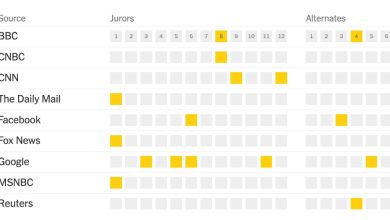From Smugglers and TikTok, Migrants Get a Message: Go to New York

Mohamed was well along a zigzag journey from his native Mauritania in West Africa, not knowing precisely where he would wind up, and not caring — just as long as it was somewhere in the United States.
But after he flew from Africa to Turkey and eventually to Nicaragua, another Mauritanian man told him that simply crossing the border was not enough. Without a specific destination, he might be detained by U.S. immigration authorities for months on end.
“You have to give them an address,” the man told Mohamed.
The fellow migrant offered him one. Mohamed wrote the address down on a strip of paper about the size of a business card, one that he would carry around like a bank note until he reached U.S. territory. The card read: “30th Stret: 400.” And then, “East 30th St. 1st Avenue. Manhattan. Subway: 6 to 28th St.”
Before he fled his country in May, Mohamed knew little of his intended new home. He could place the U.S. capital in Washington. He’d heard of Miami, mostly as a tourist destination. And he knew that in New York City there was a place called Times Square.
Now he suddenly had the coordinates — down to which subway to take — for New York City’s main intake center for homeless men.
Since the spring of 2022, New York City officials say more than 130,000 migrants have come through the city’s shelter system, with about half still there. The influx of migrants, which still accounts for about 600 arrivals each day, has overwhelmed the city’s capacity to care for them and, in turn, made New York and its Democratic mayor, Eric Adams, unlikely players in a national crisis.
Gov. Greg Abbott of Texas has bused more than 20,000 migrants to New York City from his state, saying last year in an interview on Fox News that as a so-called sanctuary city, New York deserved to be “getting a taste of what we have to deal with.”
Mr. Abbott, a Republican, recently told Bloomberg News that the migrants “are given an option about anywhere they want to go,” although in practice, the state only sends migrants to six Democrat-led cities.
“And the No. 1 choice of where they wanted to go was New York City,” he said.
The city has spent more than $1.7 billion on migrant-related costs through July, and Mayor Adams — warning the three-year tab could exceed $12 billion — has pleaded with federal officials for more aid and a shift in immigration policy.
But more than politics is at play.
New York, home to the nation’s largest number of immigrants, has long attracted migrants who come here with connections to jobs, relatives or friends — avoiding the city’s shelter intake centers and public scrutiny.
But many migrants now cross the border without friends or family to take them in, said Muzaffar Chishti, a senior fellow at the Migration Policy Institute and co-author of a recent study about the rising costs of providing shelter and other services to recent arrivals.
That is especially true in New York, which has recently drawn thousands of migrants with no connection to the city. Immigrant experts — as well as many migrants interviewed by The New York Times — said that an underlying reason is the city’s obligation to provide shelter to anyone who needs it.
“Imagine if you have no connection to family, someone telling you, you can stay without cost to you in Manhattan, in the middle of the city,” Mr. Chishti said. “I mean, that to a new migrant is a big pull factor. That was not true before this new chapter.”
In the last two months, The Times interviewed more than two dozen migrants who had chosen New York as their final U.S. destination. Some were still in Mexico. The others were in shelters or motels in New York, Albany and Buffalo. The Times has identified the migrants by their first names only, or allowed them to comment anonymously, out of concern that revealing their full names could jeopardize their status or cause them harm.
Some knew of New York’s generous shelter policy — arising from a 1981 court decree — through family members, fellow migrants, social media and even their smugglers.
The smugglers are “using this almost as a marketing tactic, you know, to say head to New York City, because you’re going to get x, y, z,” said Manuel Castro, the commissioner of the Mayor’s Office of Immigrant Affairs in New York City.
The city has tried to discourage migrants from coming to New York by distributing fliers at the southern border warning they have “no guarantee” of shelter, and is trying in court to alter its right-to-shelter policy to exempt recent migrants.
“We all want to be humanitarian,” Mr. Castro said. “But if migrants are being sent to one specific destination, it’s going to overwhelm.”
An interminable wait
Amid an array of tents near the banks of the Rio Grande in Matamoros, Mexico, the names of big American cities and states rolled uneasily off the tongues of migrants speaking the chopped-and-aspirated Spanish of Venezuela, the French of West Africa and Haitian Creole.
“We just want to go where there’s work and a good life for our children,” Yanfro, a 28-year-old Venezuelan man holding his baby boy, Gilbert, said in an interview in Spanish.
All around was the same mix of hope and desperation, spilling out of hammocks, homemade chairs and the ubiquitous tents pieced together with colorful tarps, uprooted tree trunks and scrap wood. They call the camp “Ciudad Carpitas,” or Tent City, a seemingly endless and trash-strewn expanse in what is supposed to be a riverside park. There is a teasing view of Brownsville, Texas, an official port of entry.
The punishing heat and smell — from human waste and rotting garbage — radiate misery, and the ever-present fear of kidnapping and extortion from the Gulf Cartel, born in this border city decades ago, lends an edge to the conversations.
What’s most excruciating for the migrants in Matamoros, though, is the seemingly interminable wait. Nearly all of them have signed up for preapproval to cross at the nearby bridge to Brownsville for an interview. They use a federal smartphone app called CBP One, and every day, a few lucky migrants open their app to learn they’ve finally gotten “la cita,” the appointment, with U.S. Customs and Border Protection.
“I see people who haven’t even gotten to the border yet and they already have an appointment — and I’m still here without advancing,” Mery, a 25-year-old Venezuelan, said in an interview in Spanish. She has been at a Catholic shelter in downtown Matamoros for over four months. “It’s really too heavy, this situation.”
She had been planning to live on Long Island in New York, at the home of friends she knew from Trujillo, Venezuela, and with whom she had traversed the treacherous Darién Gap between Colombia and Panama. But the friends recently stopped responding to her, and now she’s looking for a city that will provide shelter — possibly in Texas or Chicago, she said.
Mery and other asylum seekers are constantly gathering information from fellow migrants about possible destinations, including those where free shelter can be had, and New York often comes up.
Migrants crossing the border into Brownsville often provide shelter-affiliated addresses in New York as their preferred final destinations, such as the Jerome Avenue Men’s Shelter and the PATH intake center in the Bronx; the Candler Building shelter in Times Square; and a dormitory that has been turned into a migrant mega shelter on Third Avenue on Manhattan’s Upper East Side, according to records obtained by The Times.
“We were told that in Manhattan they give you help,” Susana, an Ecuadorean, said in an interview in Spanish. “There is like, some assistance, a program where they give you a place to live or a room in a hotel.”
She has been waiting, along with her two daughters, at a family-oriented Catholic shelter in Matamoros. Still, she said she planned to join her husband in Orange County, a suburb just northwest of the city, even though his living arrangement there is tenuous.
Looking for Pedro
The Times interviewed four Mauritanians in Buffalo, including Mohamed, and two in Manhattan. The interviews in Buffalo were conducted through an Arabic translator; the ones in Manhattan were done in French. The migrants did not know one another before leaving the troubled West African nation, which, in 1981, became the last country in the world to abolish slavery.
At least one left his homeland for political reasons; others left to escape poverty and violence. Yet all six followed a similar path to the United States, slipping through a hole in what several of them called “the Trump wall” in Arizona on the US.-Mexico border. Each had the same East 30th Street shelter in mind after learning about it from neighbors, other migrants or smugglers.
They all booked a series of flights that started with one to Turkey and ended in Nicaragua, with several stops along the way.
Nicaragua extends a loose and inexpensive visa policy to Mauritanians and citizens of some other countries, allowing them to reach North America without using smugglers and delaying the hardship they would encounter once the air travel ended and the ground game began.
At the airport in Managua, Nicaragua’s capital city, they all knew in advance to ask for a man who is featured in a popular TikTok video thanking Mauritanians who come to the United States for trusting him. They knew of him only by his first name, and had so thoroughly memorized his face that he seemed — as one of them put it — “like your uncle.”
“Are you looking for Pedro?” Mohamed was asked after he walked out of the airport.
“Yes,” he said, using one of just a handful of English words he knew.
Pedro took them to Honduras, where other smugglers took over in Honduras and then Guatemala. The hardest and most expensive part of the journey was Mexico, where violence, crooked police and the threat of deportation always loomed.
All six of the Mauritanians eventually crossed the border by Lukeville, Ariz., then flew to New York after being briefly detained in Tucson. They spent between $10,000 and $15,000 for the entire trip — flights, smuggling fees and bribes included — with proceeds from the quick sale of cars, land and, in one case, four camels that one of the migrants stole from his estranged father.
A ring of hope
Not every migrant who ends up in the city’s care intended to do so. Nilson,39, left Maracaibo, Venezuela, planning to stay with a cousin in Paterson, N.J. But when he got there, he discovered he was no longer welcome. The cousin gave him $30 and texted him a flier, in Spanish, with the directions to the “Centro de llegada” — the arrival center — at the Roosevelt Hotel.
“Without this help,” he said in a recent interview in Spanish, “I would have been sleeping in the streets.”
Nilson is now in Albany, one of hundreds of migrants sent by the city to upstate motels, where the city pays for their room, board and other ancillary expenses. Only two of the migrants interviewed by The Times — Ousmane, 34, and Amidou, 42, both from Mauritania — are still at the East 30th Street shelter. It’s the site of the old Bellevue Psychiatric Hospital, a decades-long symbol of despair and terror that became a homeless shelter in the mid-1980s.
Ousmane, a member of the opposition party in Mauritania dedicated to wiping out the vestiges of slavery, said he was beaten and tortured by the police there, and feared that he would be imprisoned or killed. He participated in demonstrations after his friend, a Black man named Oumar Diop, died in police custody the month before Ousmane left the country.
When he got to New York, he went straight to the shelter, its address scrawled on a piece of paper. He was told to go to the Roosevelt Hotel to be processed. But it turned out he was right the first time: He was directed back to the shelter.
Amidou, like Ousmane, got the East 30th Street address from Pedro, the smuggler in Nicaragua, writing it down on a thin strip of paper that he immediately secreted away, afraid that it would be taken from him on the perilous journey north. He carefully folded it up, rolled it into a ball and then stuffed it into the head of a barrel-shaped, silver ring.
The ring somehow also had room for another of Amidou’s guarded possessions: his voter registration card, needed for identification in case his passport got lost or stolen. Both fit neatly under a red stone in the center of the ring.
Once he crossed the border, he removed the stone from the ring and pulled out the strip of paper to show the border authorities where he would be staying. They copied the paper and gave it back to him, and he spent three daysin immigration detention in Arizona before flying to New York.
After landing at Kennedy Airport, he once again pulled out the strip of paper, this time from his wallet. The fear of having it taken from him was gone: He was in the United States at last.
He handed it to a taxi driver, to make clear his destination. Above the East 30th Street address, Amidou had jotted down a message in Arabic. “New York,” it said, “gives free shelter.”
Sheelagh McNeill contributed research.




